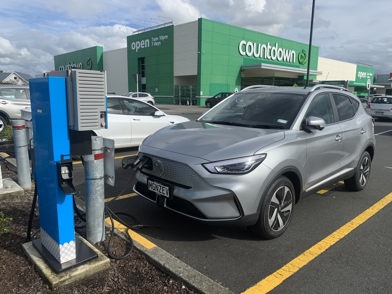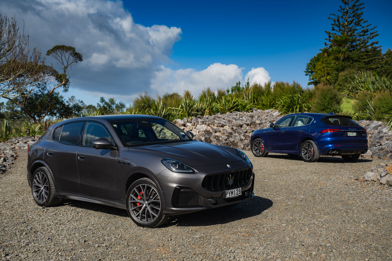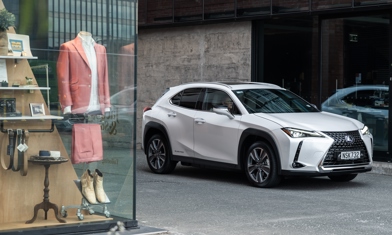Report 1 05/07/24 Report 2 25/07/24 Report 3 29/08/24 Report 4 18/09/24 Report 5 02/10/24
REPORT 5: (1st November 2024)
Mileage: 4500km
It’s time to farewell our long-term Volkswagen ID.5 Pro+. It’s a fairly mainstream EV-SUV, but you wouldn’t say its time here has been dull.
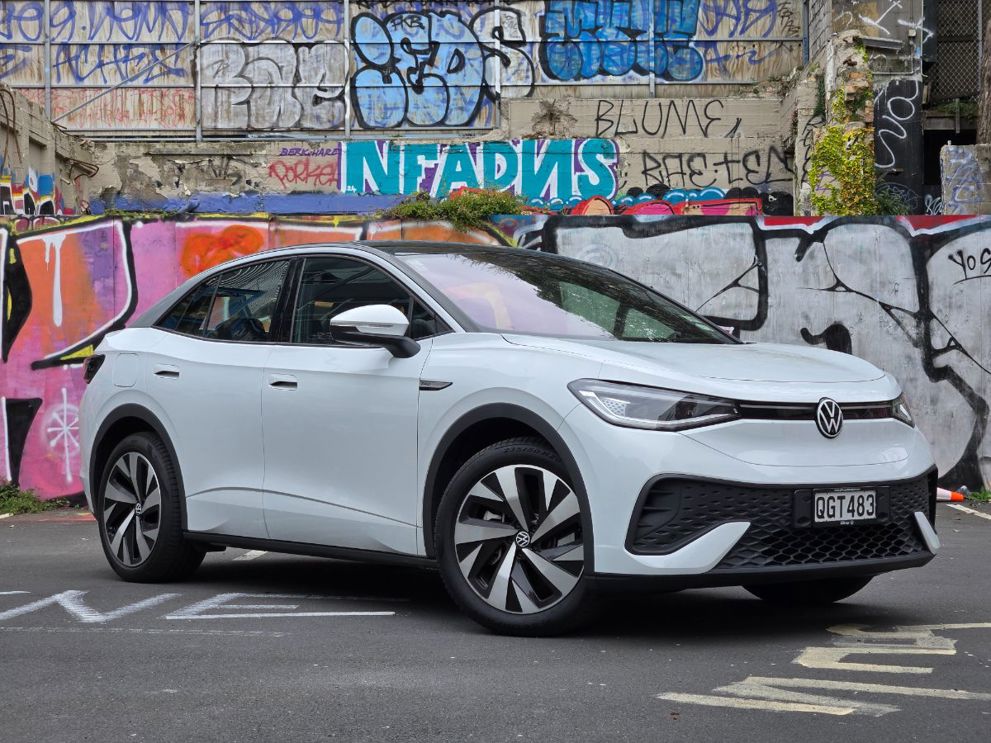
During its three months with us it’s done the city thing, completed plenty of long-distance super-commuting and even got involved in the fashion business.
It's been a quietly surprising package in many respects. None of us expected it to be a road warrior, but the ride and handling are both really polished. The powertrain is modest with a single-motor 150kW/310Nm, but it’s perky away from the lights where it counts and it’s a really relaxed cruiser.
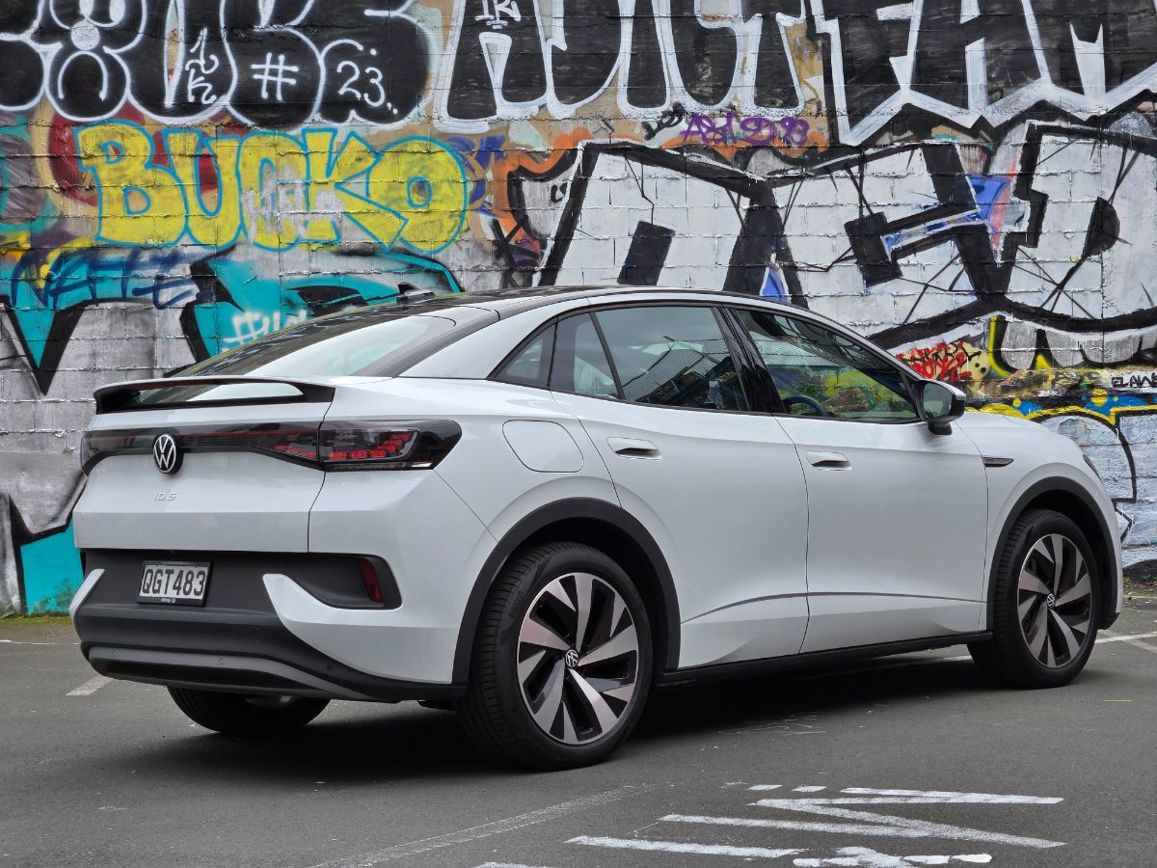
VW Group’s MEB electric architecture is fairly ubiquitous by nature, but our car’s 77kWh battery really delivers on range: it often shows more than 500km in city use and offers 400km-plus in motorway driving, which is much less friendly to EVs.
We’re still not sold in any way on the Pro+ specification at $95,490, when the mechanically (electrically?) identical ID.4 Pro is still on special at just $59,995, with a further $5k cashback until the end of the year. Sure, that’s an artificial price gap and the product of VW NZ’s desperate need to clear EV stock (it and every other Kiwi brand)... but it exists.
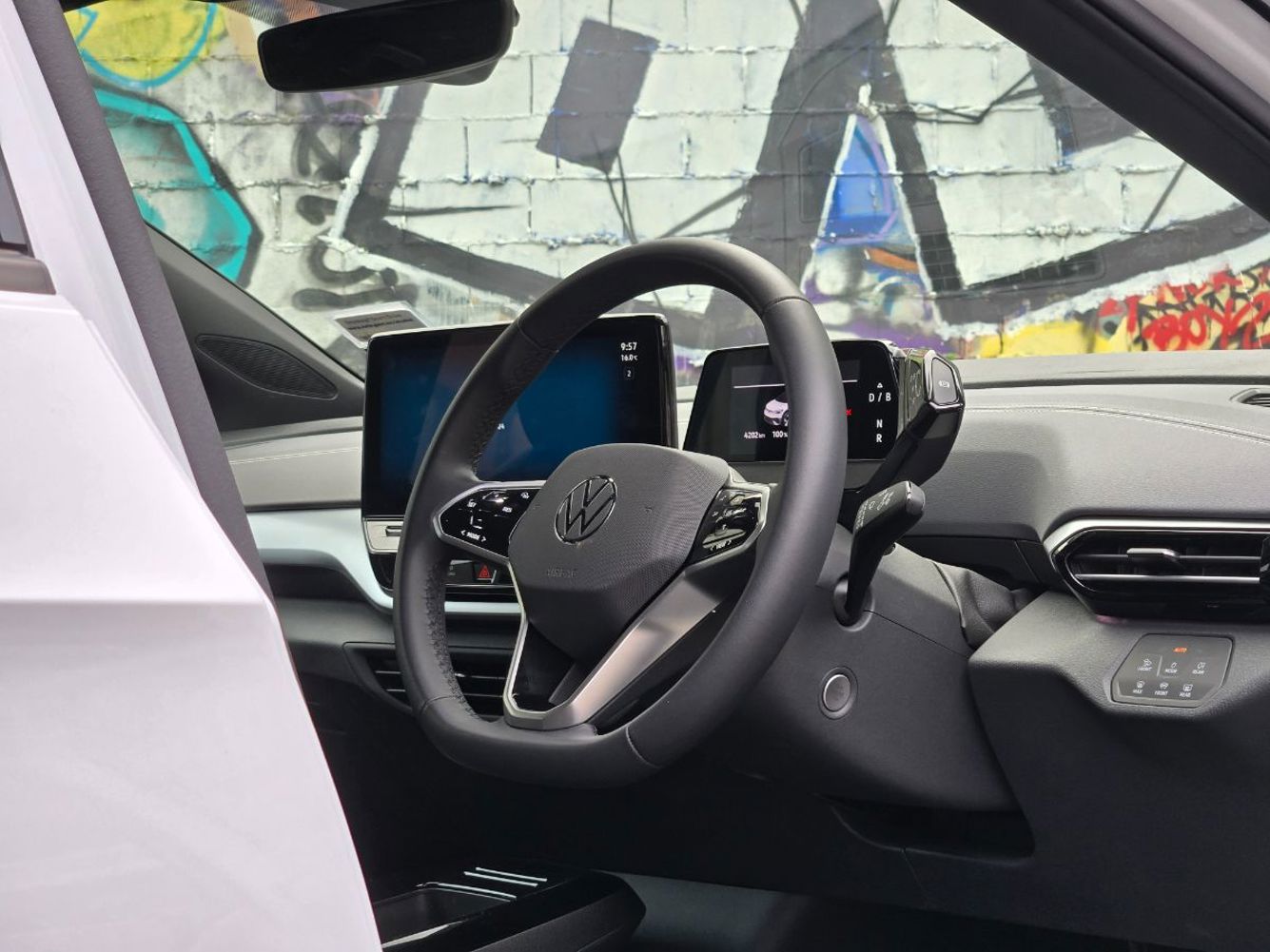
The big thing going in was VW’s revolutionary near-buttonless interior; the ID was one of the first vehicles to have it and there’s been such a global backlash, the German maker has undertaken to bring physical controls back - the new Golf being a good example.
One of the good things about having the ID.5 long-term is that we’ve had a chance to get used to the cabin ergonomics and while they are far from perfect, we honestly haven’t had too much trouble getting to grips with all the touch and haptic surface controls. Some of us quite like them.
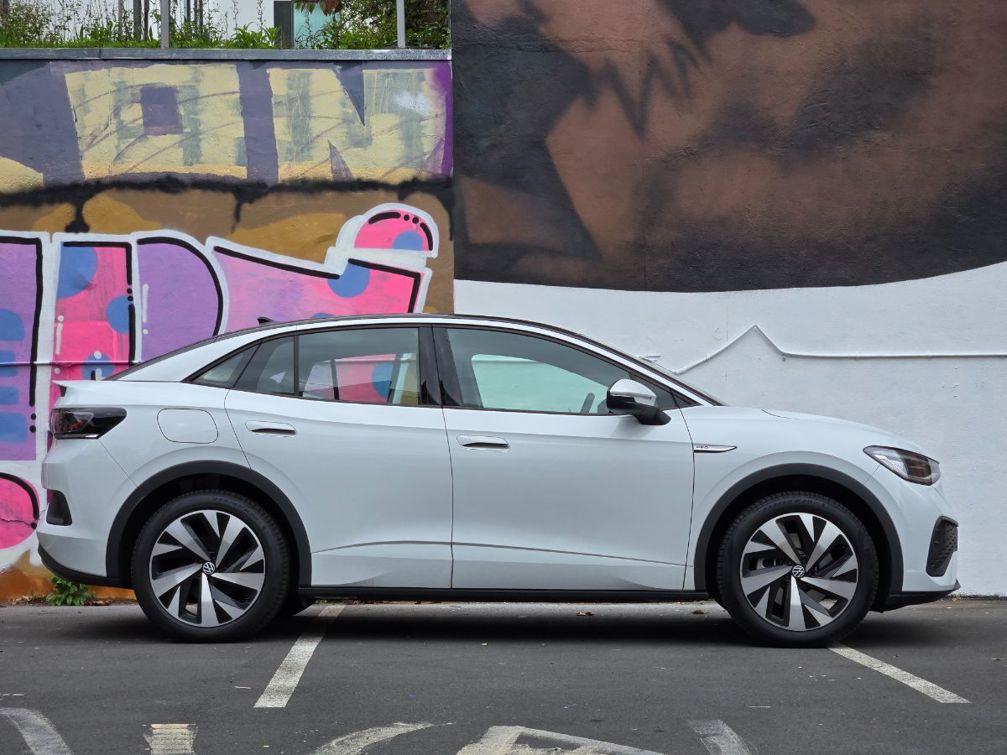
So, ID.5 (ours, the coupe-style one) or ID.4 (SUV)? They’re currently the same price in Pro specification and pretty similar in most respects; the general consensus around here is that we like the more balanced look of the 4 more, but the 5 has few functional advantages: bigger 12in screen across the range (the 4 has a 10in display), a slightly better boot (549l versus 534l) with a double-floor and 11km extra range thanks to a more aerodynamic shape.
The lack of live services should have irked, but it hasn’t really been a thing; maybe you can’t miss what you can’t have. VW’s voice assistant is quite versatile, but we quickly shut off the prompt function in favour of push button activation, because it woke up incessantly during in-car conversation when it wasn’t wanted.
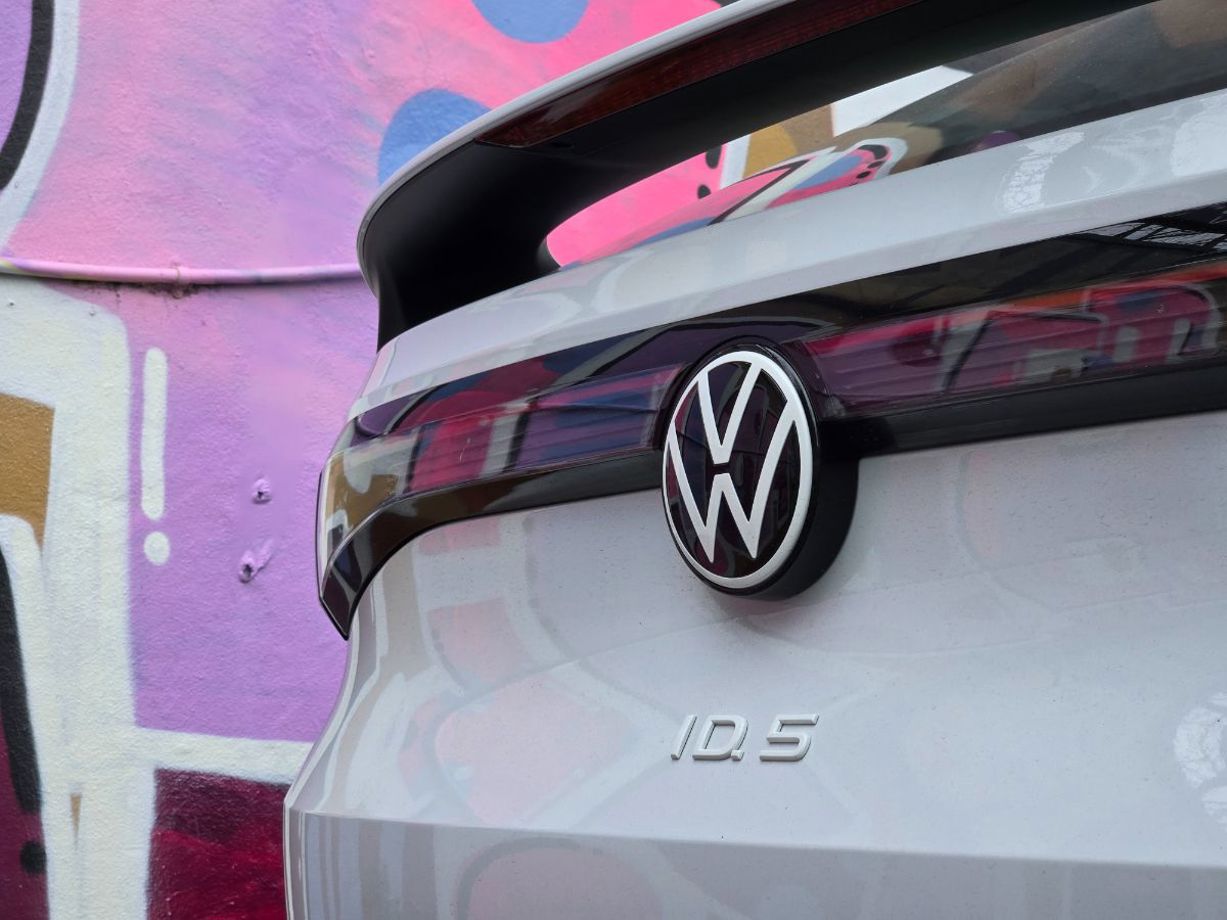
The lack of a power tailgate (even on our expensive Pro+) is still mystifying. And while our car has power front seats, be aware that the Pro model has manual adjustment for those too.
But would we recommend the ID? Yes. It’s a really good car that grows on you; and at current pricing, it’s an unbelievable amount of EV for the money.
- David Linklater
REPORT 4: (18th September 2024)
Mileage: 3950km
DRIVEN Car Guide’s long-term Volkswagen ID.5 has been my ride this month; here's what I think. My work as a costume designer for film and television means I often cover large distances (sometimes to remote locations) each day, my vehicle loaded to the roof with clothing and a bunch of other stuff.

I also spend a lot of time driving around Auckland, sourcing clothing and accessories, so my ride has to be urban-friendly and easy to park.
I don’t like boring cars and tend to take a design led/sometimes quirky approach when choosing a vehicle. In the past I’ve owned Lancias and Saabs. With a need for greater practicality for my freelance role in recent years, I’ve had two Skodas (Roomster and Yeti) and two Seats (Ateca and Tarraco, both FR models).
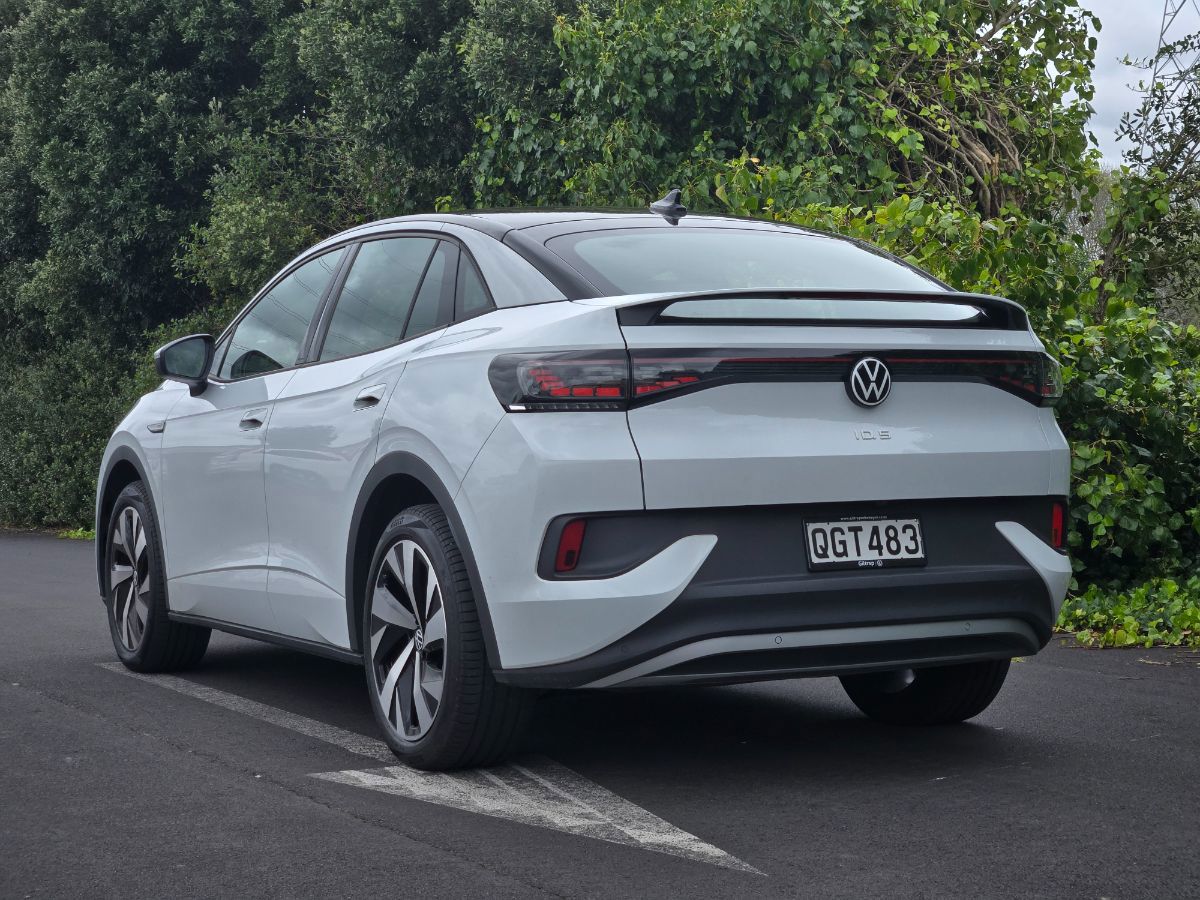
This ID.5 connects with me, because I’ve owned an ID.4 Pro for nearly a year now. It replaced my Tarraco, which I loved, but I wanted to go for something more environmentally friendly.
I need an SUV for the load height and space, as well as good ground clearance for location shooting in country areas. AWD is a bonus (both my Seats were) but not essential.

I tried a couple of hybrids, but they weren’t enough of a step forward: it just made me more certain I wanted to be petrol-free.
I looked seriously at the Hyundai Ioniq 5 (love the style but the boot is tiny), Ford Mustang Mach-E (nice design and the Mustang name, but also pretty masculine, and the interior was a bit creaky) and Skoda Enyaq (appealing and techy, but the design felt conservative).
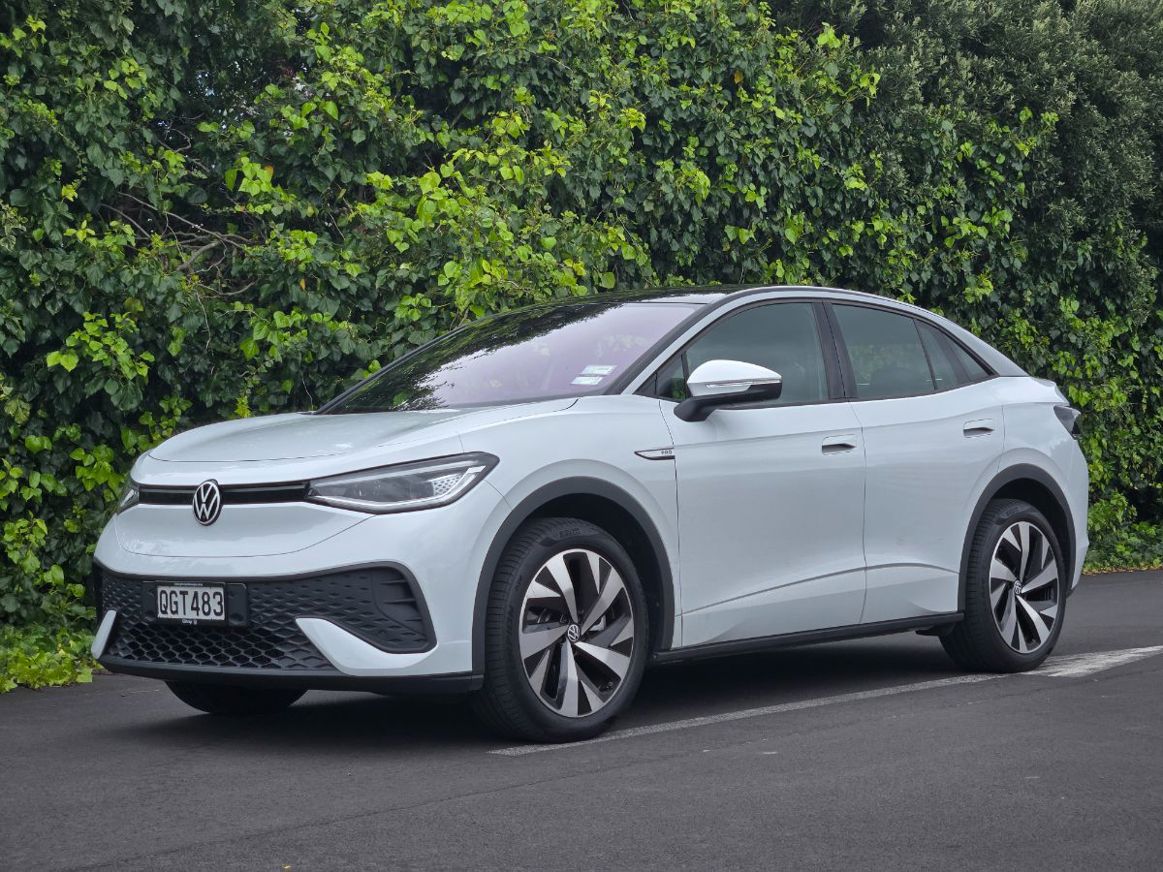
I chose the ID.4 because it looks more futuristic, but is also clearly a VW. I learnt to drive in a VW as a teen; I have history and an emotional connection to the brand.
I love the clean interior design with the touch controls. The ID.4 is really spacious with a big boot and real-world range of 400-500km (depending on what kind of driving I’m doing) means it’s practical for me even on busy driving days.
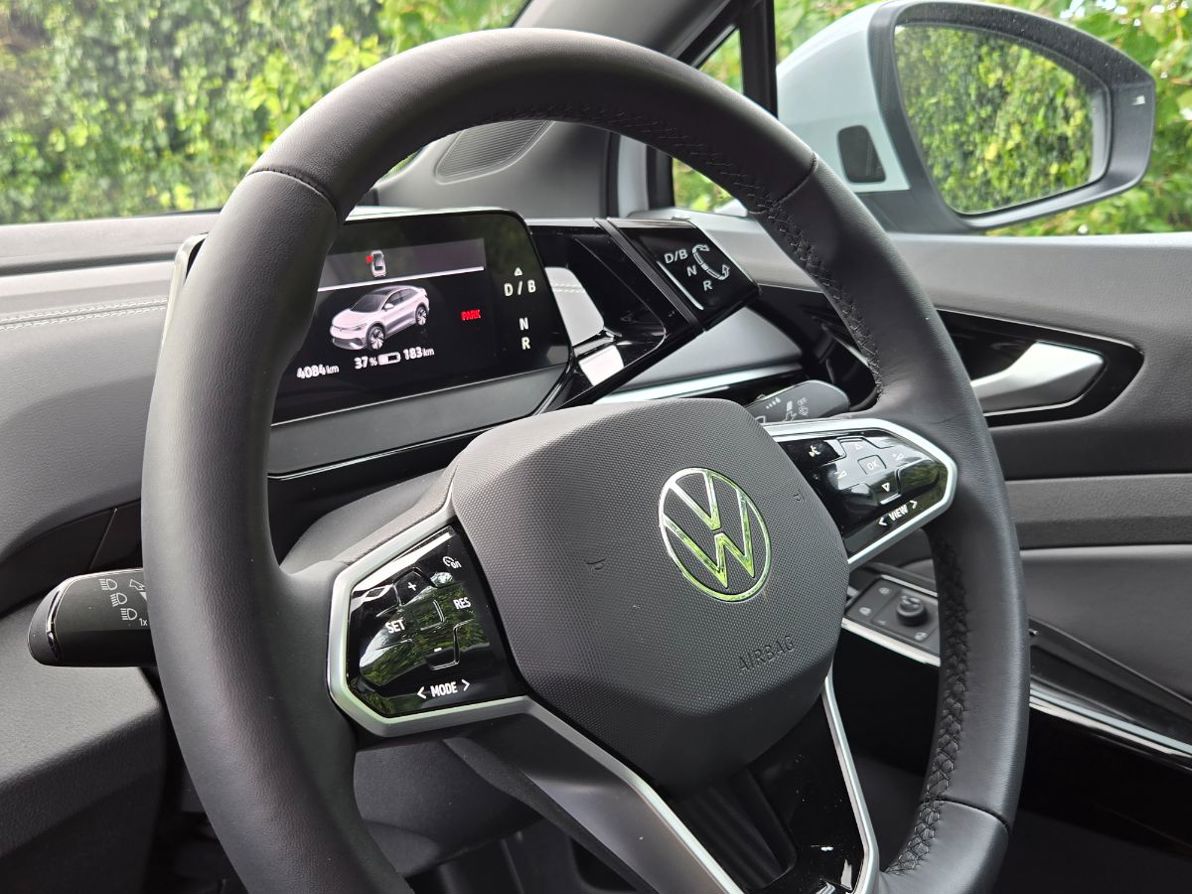
I admit I had range anxiety as a first-time EV owner, but once I got an Evnex wallbox installed at home, I honestly haven’t experienced battery-level panic or frustration with charging times at all. If I’m away overnight I might use public stations, but 95% of the time I plug in overnight at home. It’s so easy.
I was interested to experience the ID.5 because I seriously considered it when I purchased my car. I preferred the look of the ID.4, but the price difference was also a factor. That doesn’t exist right now: you can buy either for the same amount.
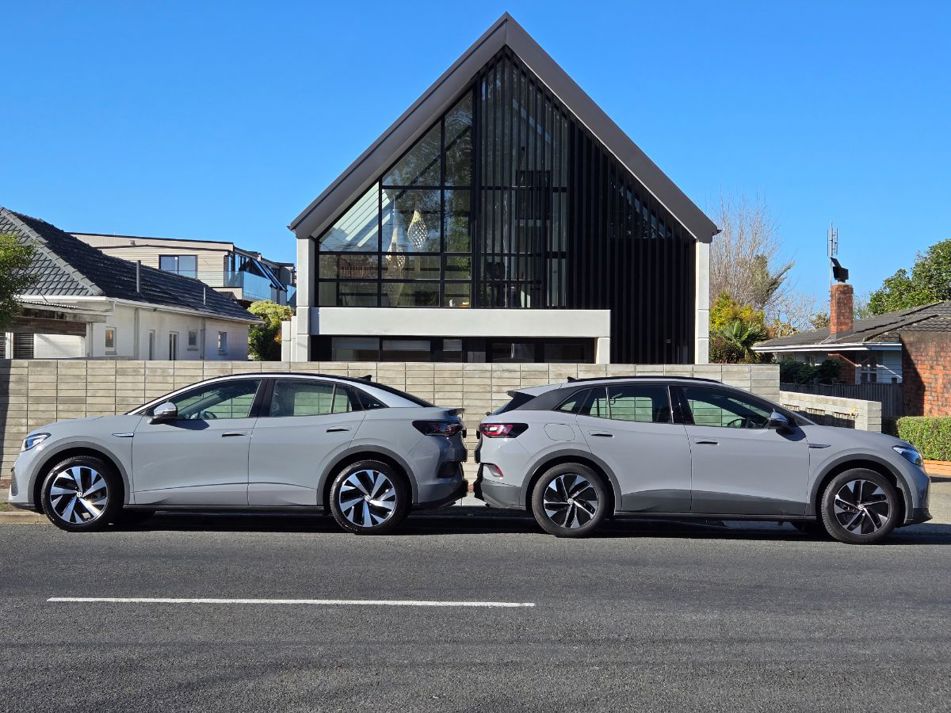
They are exactly the same underneath, so I’m comfortable driving the ID.5; it feels familiar. I love the way EVs can boost away from the traffic lights and the adaptive cruise control system is by far the best of any car I’ve had. The ID makes city driving more fun.
I prefer the larger screen in the ID.5. The display in my car has always looked a bit small to me, although they both do exactly the same thing.

The ID.5 is marketed as the coupe version. It has a slightly bigger boot than the ID.4, but the difference is minimal. The most important space for me is probably the back seat, because I carry a rack for clothing and it all needs to hang straight to lessen garment maintenance. The ID.5 roof is still quite high over the back door, so it’s still easy for loading and unloading. I like the flat floor, because that’s useful load space as well.
I can see the appeal of the double-floor boot in the ID.5 (which my car doesn’t have), because you can store cables and other smaller items in there. But personally, I’d probably take it out straight away because I need as much volume as possible. My car came with both three-pin and Type 2 charging cables, but I don’t carry either around with me; slow charging is for home and I hardly ever need a power top-up when I’m out; if I did I’d head to a DC fast charger.
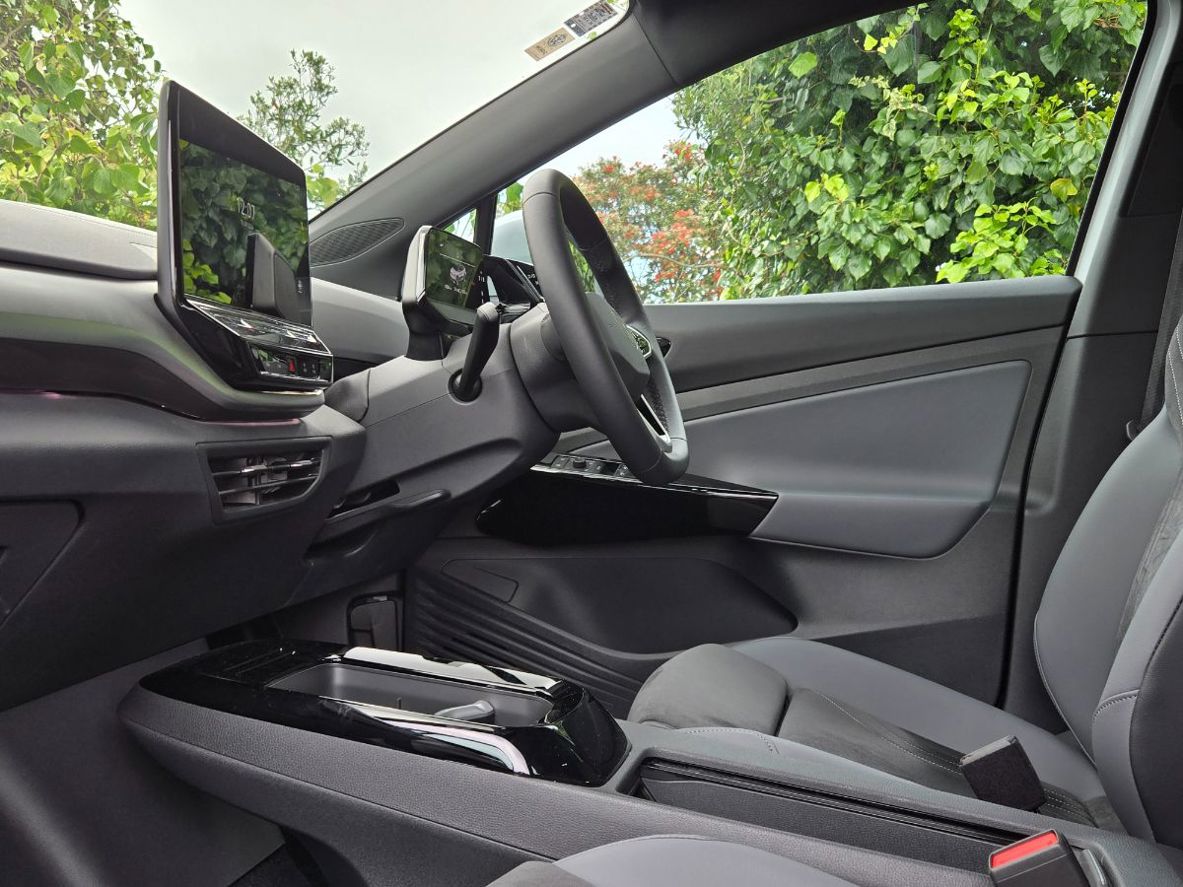
I don’t know whether I’d want or need this Pro+ model; definitely not for an extra $30,000! The techy lights and larger wheels are cool, but not essential. The seat massager is slightly creepy (I’ve tried lots of others that aren’t anywhere near as weird).
There are three things I’d love to have on my car:
- Remote power tailgate because I’m always loading shopping bags; this was almost a deal-breaker when I bought it. I was used to the efficiency of hands-free and adjustable height (my garage roof is very low) on both Seats.
- Wireless Apple CarPlay seems essential these days.
- Live services like some other EVs, where you can control stuff and get information through a phone app.
As the Pro+ still doesn’t offer these features, I’m very happy with my ID.4; actually, I love it.
- Sara Beale
REPORT 3: (29th August 2024)
Mileage: 3250km
A virtually buttonless dashboard is one of the more controversial aspects of the Volkswagen ID.5. A cabin concept first introduced in the Golf 8 back in 2019 (2021 for New Zealand), it eschews physical controls for haptic touchpads and sliders.
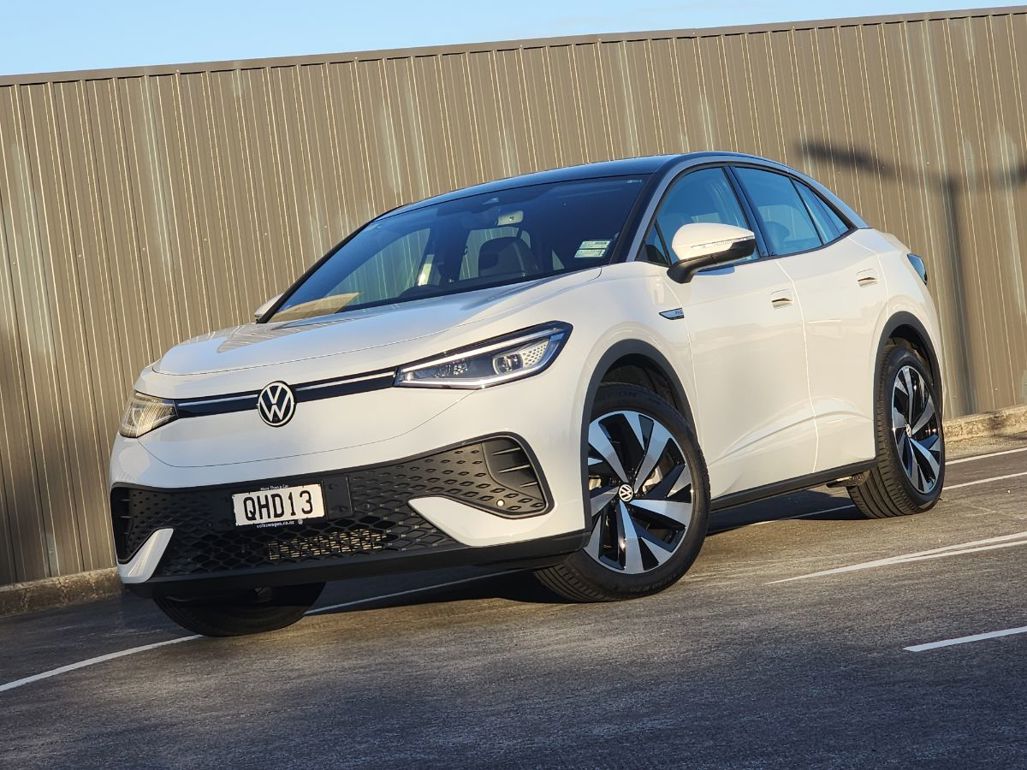
After many global customers throwing up their hands very high indeed, VW admits it might have gone a bit too far; it’s already put a few physical controls back into the mix for the Golf facelift and all-new Tiguan, and future ID updates will no doubt follow.
One of the good things about a long-term test is the ability to actually live with bold new features like these and become familiar, rather than grappling with them before moving onto the next new car and next confusing thing.
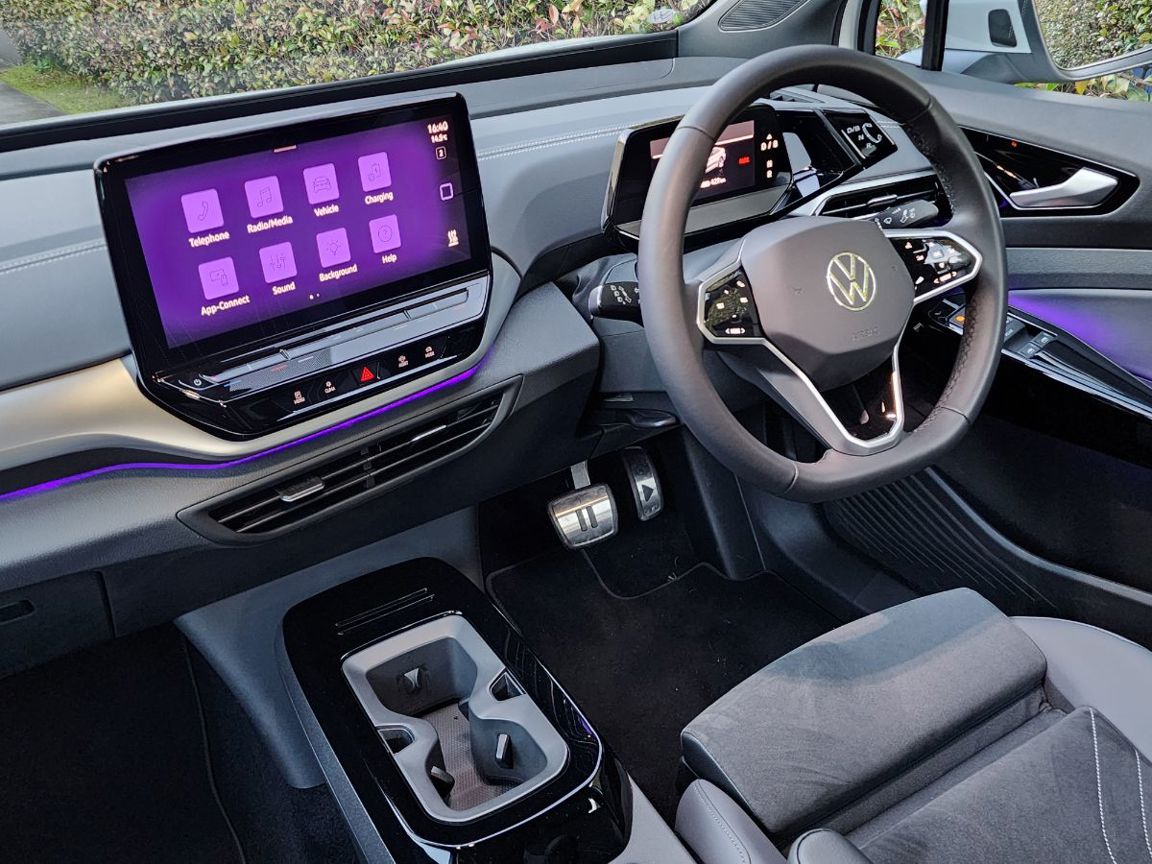
So at the risk of sounding like an ID apologist, I’ve come to accept and, ahem, like this touchy feely cabin environment, even if it does come with a couple of seriously head-scratching issues; more about those in a minute.
In fact, after a couple of months in our ID.5 and even more in a non-work-related ID.4 (basically the SUV version of the coupe-style 5, and basically the same), I’d say I understand why VW thought this was all a good idea.
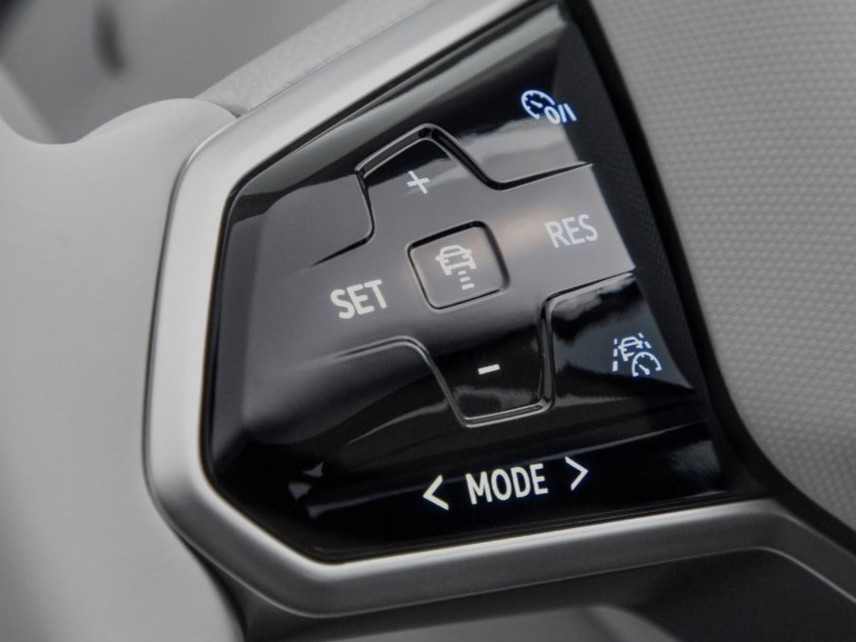
The button-like controls on the steering wheel (adaptive cruise, for example) can be pressed, touched or even swiped depending on function, with light feedback coming through as they activate. You can press as hard as you like of course, but I rather like the sensation of applying a more delicate touch and the car talking back to me.
There’s been quite a bit of pushback on the ID’s audio volume and climate-control temperature touchpads, both on the centre console. They can operate as pseudo-buttons (just tap at an appropriate spot for up or down), but you can also use them as virtual sliders.
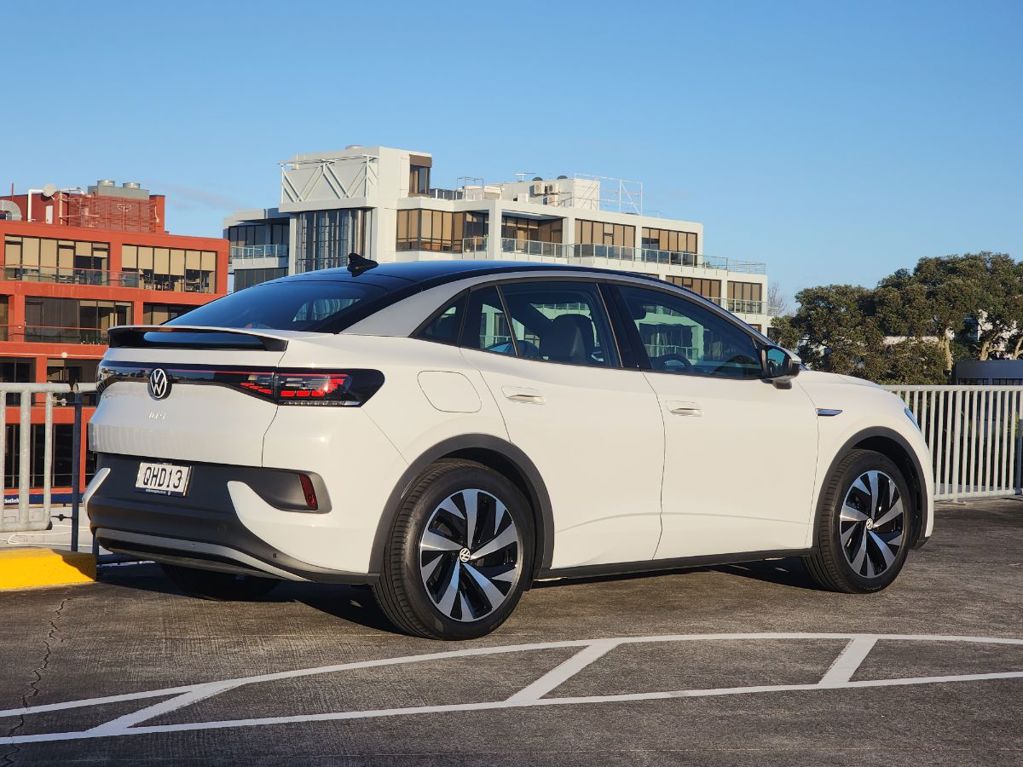
So far so good, but the big fail is that this section of the console is not illuminated, meaning you can’t see any of it at night. That would be tricky enough with conventional buttons, but it’s a major problem when you really can’t feel anything.
Not good enough, but one of the things about the ID is that there are multiple ways to do the same thing. For climate, there’s also a touch-shortcut that brings up a comprehensive menu on the infotainment screen, including “smart climate” settings to warm your feet, demist the windows…. or whatever.
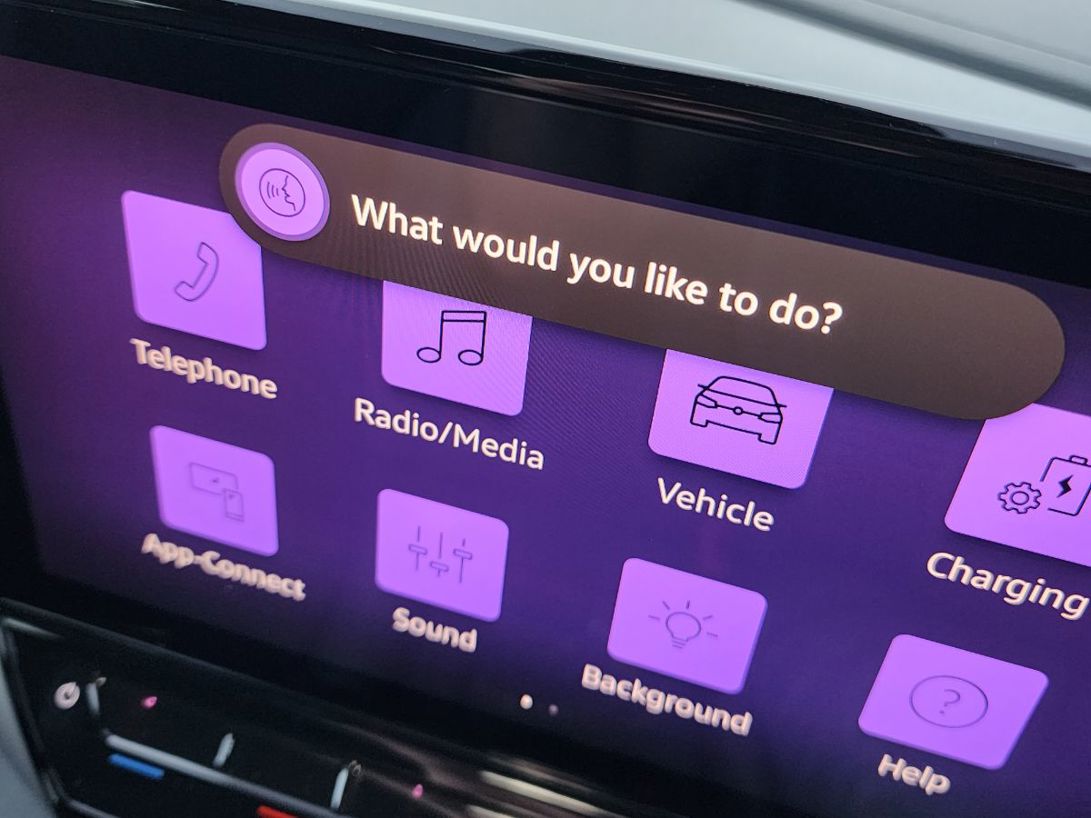
A key part of the ID cabin concept is the intelligent voice assistant, which can be woken by the “Hello ID” voice prompt or a touch of the steering wheel control. Nothing new in the world of high-tech cars of course, but Hello ID can do quite a lot, to the point where you really don’t need to use any of those touch-controls if you don’t want to.
“Hello ID, make the temperature 20 degrees”, “Hello ID, make the audio louder”. You get the picture.
We have found the voice assistant is prone to waking up at weird times when a human conversation is going on in the car, to the point where we're now trying it with the voice prompt disabled (an easy setting in the infotainment screen) and simply activating the assistant with the steering wheel control. Easy.
There’s a light bar at the base of the windscreen that illuminates in white to let you know the car is listening - that conversation-with-the-car idea again. The same light bar can glow red to warn of following distance or green to tell you it’s charging. And so on.
So the idea with a car like the ID.5 is that you learn what it has to offer and decide which way suits you best to operate all those cabin functions. And yes, as owners we’re getting there.
For such a clever car, the elephant in the room is probably the lack of “live” services. VW ID models have SIM cards and remote cellular connectivity overseas, including over-the-air updates and mobile phone apps that link car-with-owner. VW NZ doesn’t have that back-end sorted yet; in fairness, neither do sister brands Skoda and Cupra, which have cars on the same platform. It’ll all happen together, but there’s no sign it’s happening soon.
That’s a bummer when other EV brands have comprehensive online services to offer through their vehicles, but on the VW side maybe you can’t miss what you never had.
- David Linklater
REPORT 2: (25th July 2024)
Mileage: 2200km
So, the Volkswagen ID.5 has joined our garage for a few months, and while EV popularity is at a relative low, any chance to save on fuel bills is one anyone would relish.
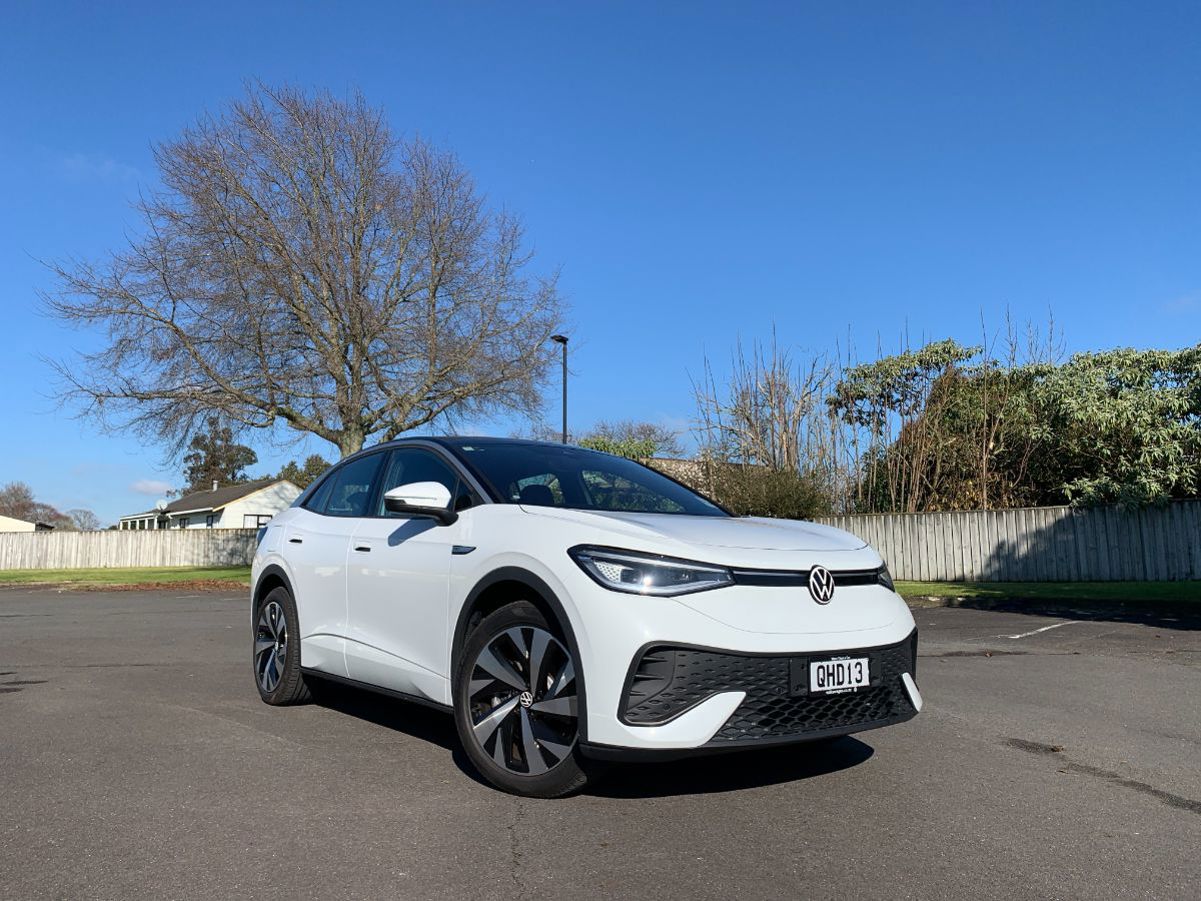
Equally, any EV with solid range is much appreciated. It’s odd how one of the headline questions about EVs is their range. It’s almost taken for granted, but it’s like grabbing a new Toyota RAV4 and asking what l/100km it gets. Sure, it’s interesting, but not the first thing I’d ask.
Climbing into a 100% charged ID.5, I was pleased and impressed to see range of 505km.
But it’s often the first thing “I” check when presented with the key options to take home, given I’m clearly the strangest in the Auckland office by basing in Hamilton. That 260km round trip is often 300km+ with diversions, groceries and/or afternoon school and sports runs, so a typical 300-350km EV can be tight in the dry: and in winter with lights and/or wipers, it’s getting very range anxioutigous (a new word I made up).
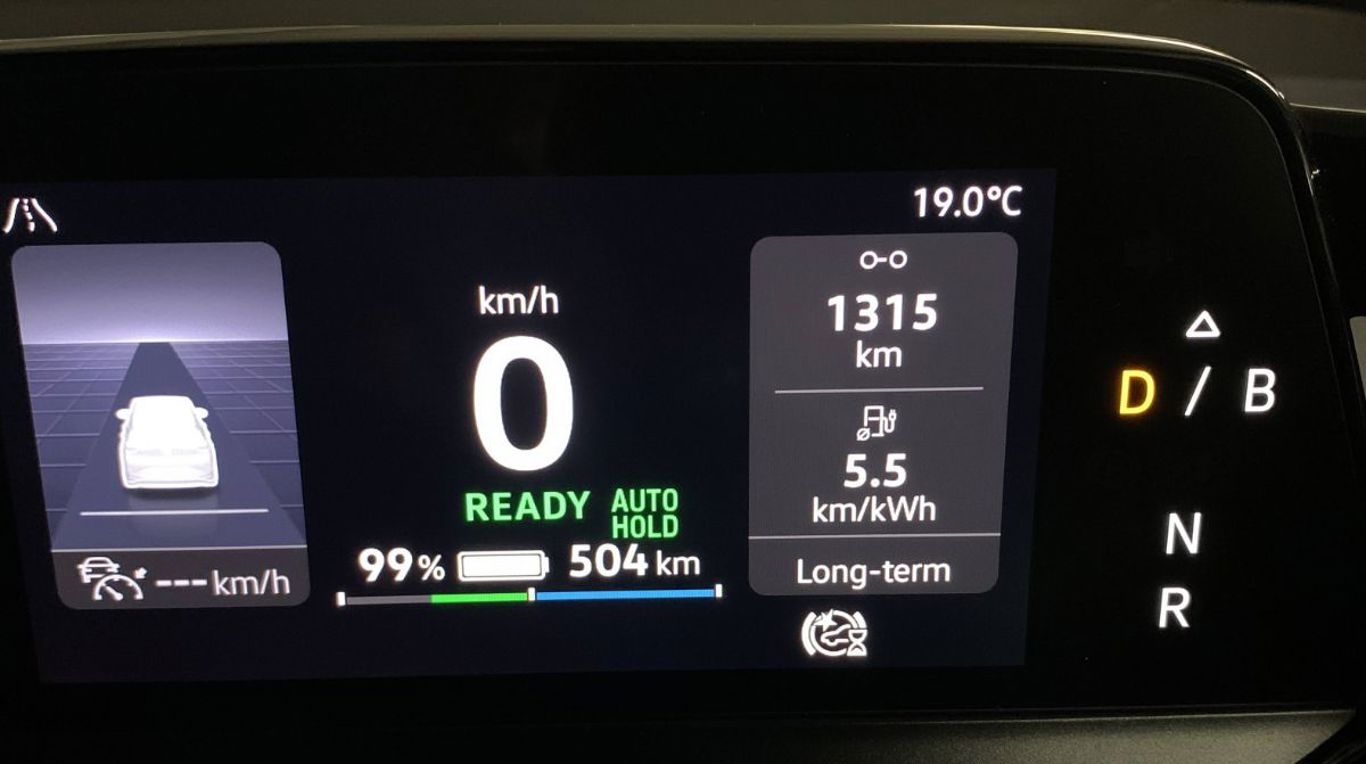
So, when climbing into a 100% charged ID.5, I was pleased and impressed to see range of 505km. And after a week and a few hundred km in the ID.5, it’s rather growing on me. I’m not a big fan of the haptic buttons on the steering wheel, but they do become easier to live with over a longer time, and that extended duration has revealed shortcuts to key menus, here and there: like the climate, drive modes and quick button controls near the right knee for light controls and demisting.
On the EV side, it’s all rather basic: no adjustable energy regeneration, just a D (for Drive) or B mode for higher regeneration.
There are fun additions, like the pause-play symbols on the pedals; and the large storage bins are very handy, being modular enough to move the cupholder insert to the high or low position, and a divider, for keeping smaller things at one end. Though the manual tailgate does feel a little low-rent on this $95k Pro+ model: less-so on the $60k ID.5.
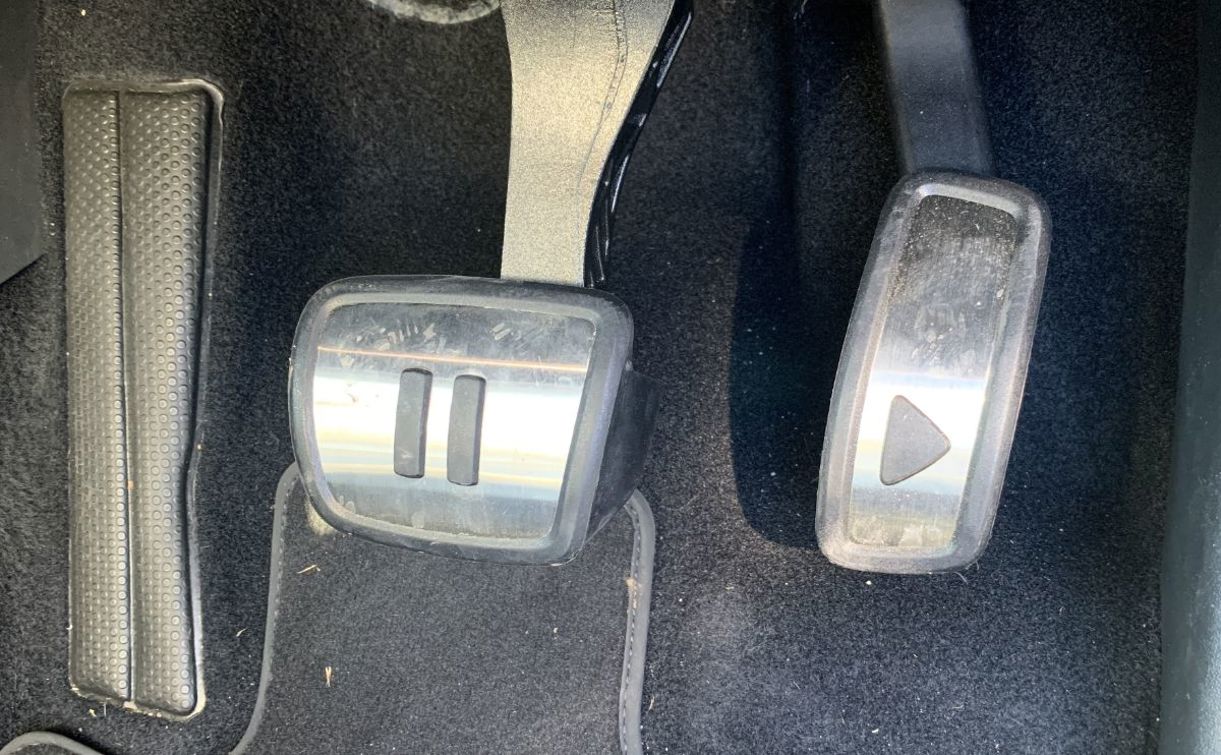
Joining the extreme sport that is Auckland motorway traffic, I happily select radar cruise control and let the ID.5 take over, and it’s a very good system, able to stop-start, but on the EV side, it’s all rather basic: no adjustable energy regeneration, just a D (for Drive) or B mode for higher regeneration.
I’ve found B mode works better for me, and the ID.5 turned in between 18-22kWh/100km, depending on if it was suburbs or motorway driving. Though a small caveat: our car measures it in the overseas way, with km/kWh, ranging between 4.5-5.5.
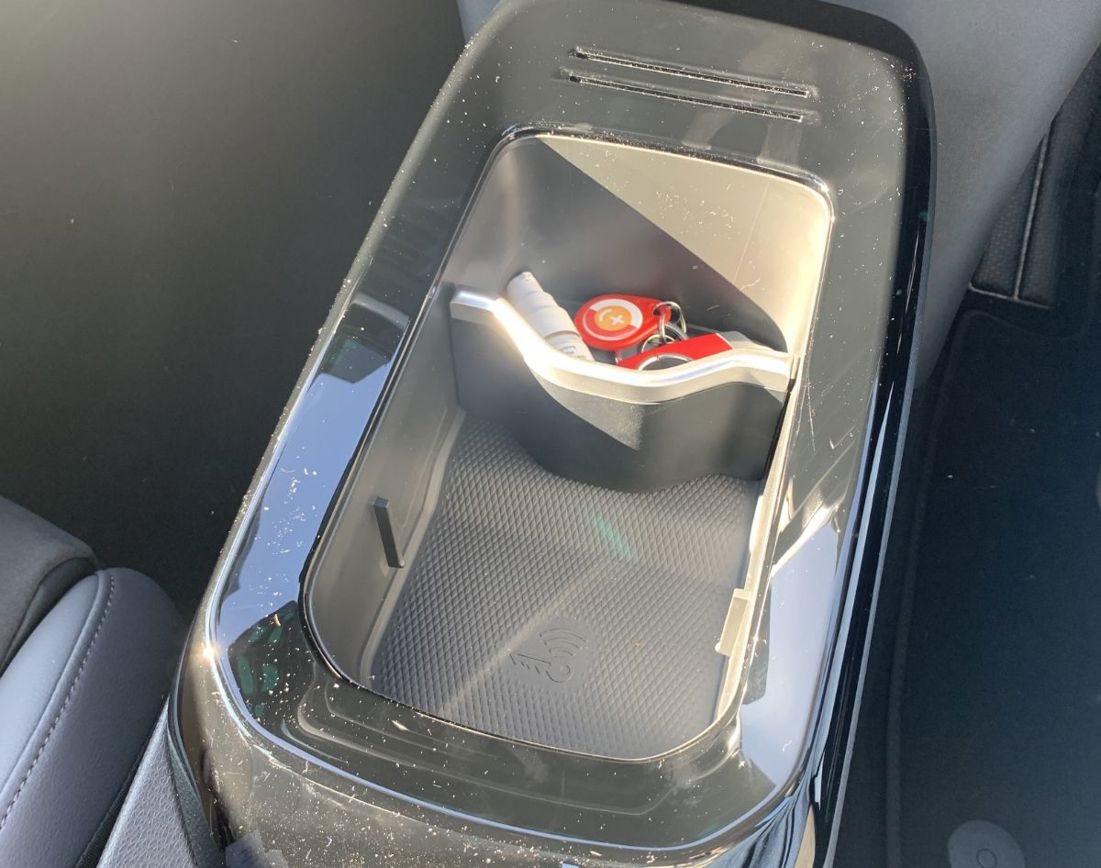
The ID.5 seems simple and very much a set and forget style of EV. Enter, go, stop, exit, park brake, it’s all automated from the gear selector/park button.
The charging side has been a different story as we’ve alternated between our 7kW Wallbox at work, which does a great job at pumping power back into the 77kWh battery while we sit at our desks. Or there’s the fastcharging, that we’ve been doing at Bombay: while the chargers offer 300kW, and the ID.5 is able to accept up to 135kW, we’ve seen energy input go as high as 107kW when the battery was at 30% and around 15 degrees ambient. That means a real-world charge time around an hour, given the charge energy tapers off as the battery nears full.
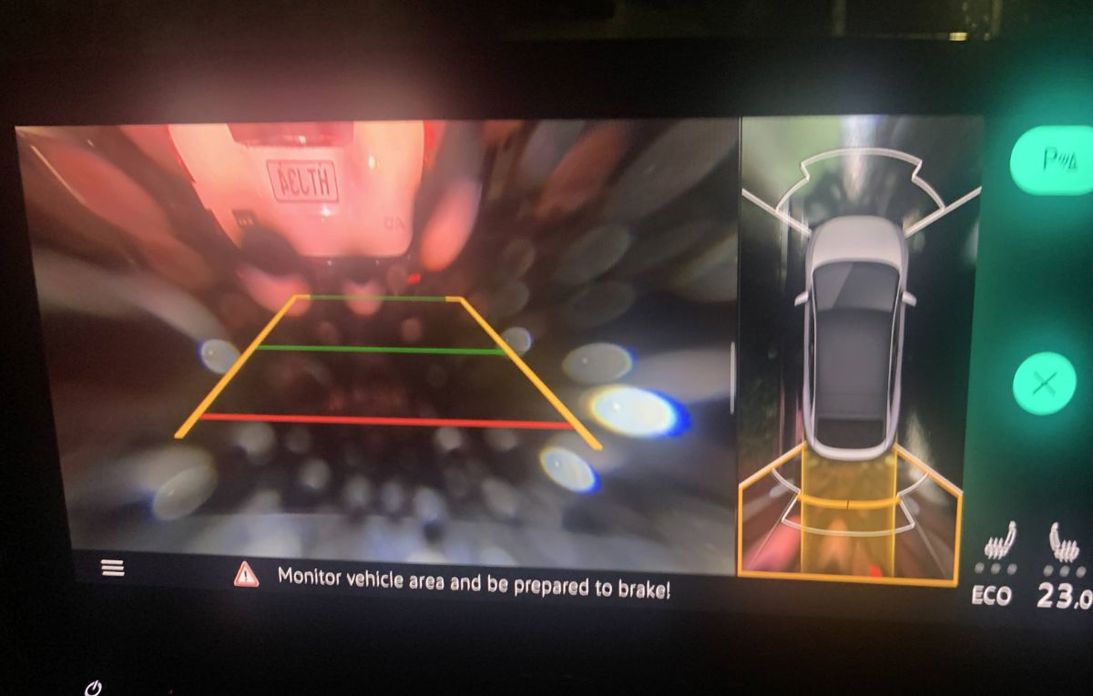
My mostly motorway miles have meant the ID.5 has reassessed its opinion of what I can get from a full charge, which is still a solid 400km+. More suburban driving brings it back closer to its WLTP claim of 516km.
It’s modestly quick enough: VW claims 8.4 seconds to 100km/h and that’s exactly what we tested on our RaceBox meter.
It certainly has visual presence when parked next to other cars, with its modern styling, and though its white paint is meek, that’s partly a good thing, with the ID.5 looking smart and neat, and comfortable enough for a six-footer to be comfy in the rear seats without complaint.
We did have an issue with rear vision, given all the wet weather, lately: not only does it lack a rear wiper, but its reversing camera is prone to being covered with water droplets, hampering vision. Minor things, on the whole.
At $60k, the VW ID.5 a lot of car and a lot of EV for the money, and it’s proving much better to live with long-term, getting more familiar with its quirks.
- Dean Evans
REPORT 1: (5th July 2024)
Mileage: 1189km
To describe the state of the New Zealand battery electric vehicle (BEV) market as “turmoil” is an understatement. After a boom 2023, sales have gone flat following the removal of the Clean Car Discount (CCD) and enormous discounts are now the norm; there’s also a lot of uncertainty about the saleability and value of used EVs right now.
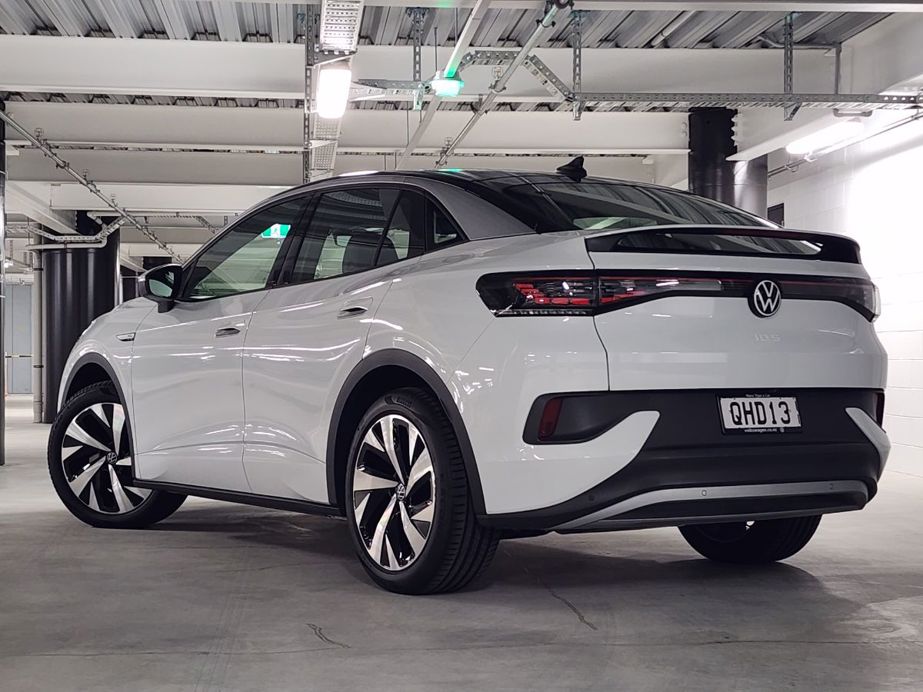
So it’s a challenging time, especially for those in the industry. But here’s another perspective: for car buyers who are thinking about actually purchasing an EV, it’s the best possible time. The technology is not going away and everything will eventually settle into a sales rhythm at whatever level… the level will be. It just takes time.
The ID.5 is essentially the coupe version of the ID.4. But the two are basically the same underneath.
That’s our thinking behind adding another EV to the long-term fleet. Specifically a Volkswagen ID, for a variety of reasons. First, we really liked the lineup when we drove it last year, and we haven’t spent a huge amount of time in any ID model since. Second, VW has been one of the most aggressive with its discounting, probably because it has a lot of stock on the ground - after fighting so hard to get good supply through Covid, global demand and component shortages, following the model’s European release back in 2020.
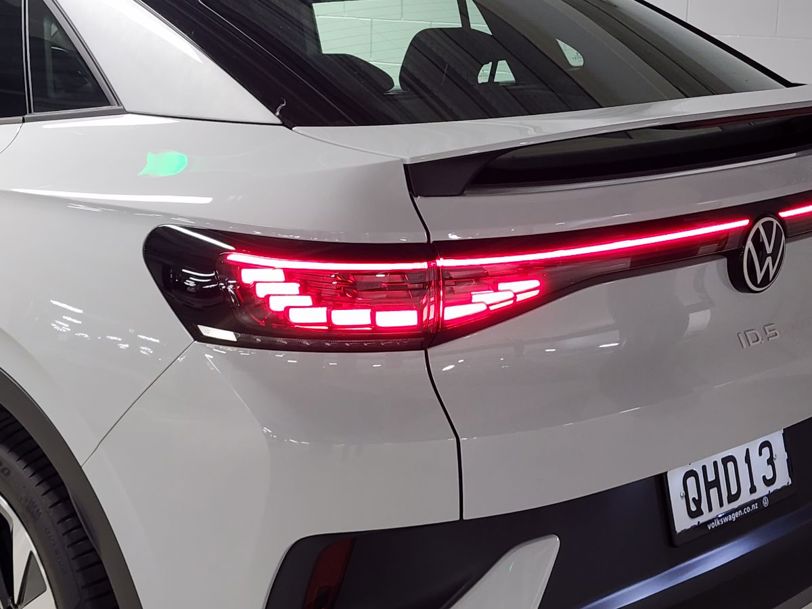
The ID.4/ID.5 range was launched in NZ nearly a year ago, at prices ranging from $79,990 (to take advantage of that now-defunct CCD) to $95,490. Changes between then and now are too numerous to mention, but right now VW NZ is offering the model from a gobsmacking $59,990 “while stocks last”. It’s a lot of car for that kind of money.
VW NZ supplied our ID.5 in top Pro+ specification, which does bring some delicious extras.
Meet our new long-termer. It’s the ID.5, which is essentially the coupe version of the ID.4. But the two are basically the same underneath, based on the VW Group’s MEB platform, with a 77kWh battery powering a 150kW rear-mounted electric motor. It’s a close relation to the larger Skoda Enyaq and smaller Cupra Born (all three have the same wheelbase).
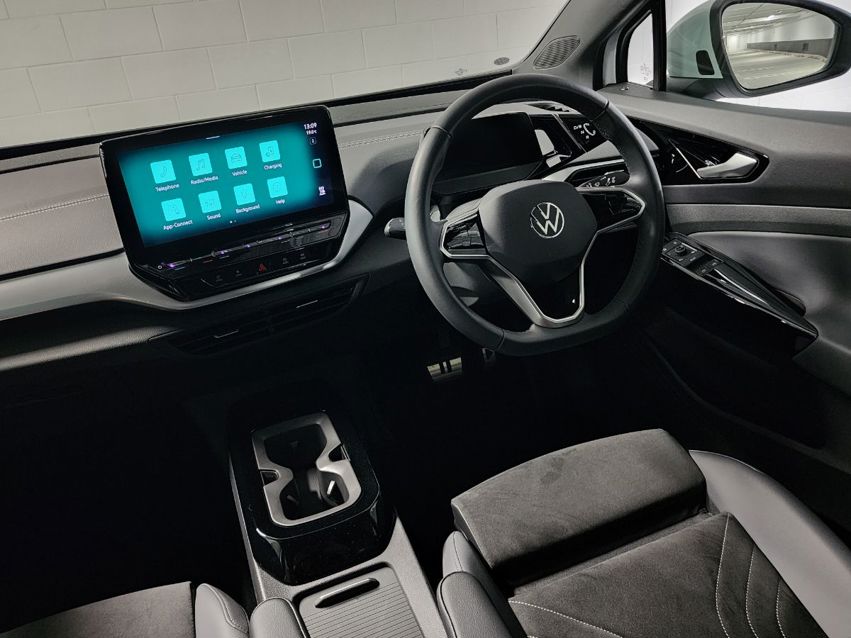
Oddly, the ID.5 actually gets a bigger boot and better range than the ID.4 (530km versus 513km), thanks to a longer, more aerodynamic shape. But really, there’s not a lot in it.
VW NZ supplied our ID.5 in top Pro+ specification, which does bring some delicious extras: 20-inch wheels, IQ.Light matrix headlights and 3D rear lamps with startup/shutdown light show, light bar at the front, superb “ergoActive” front seats with memory/massage function and upgraded audio.
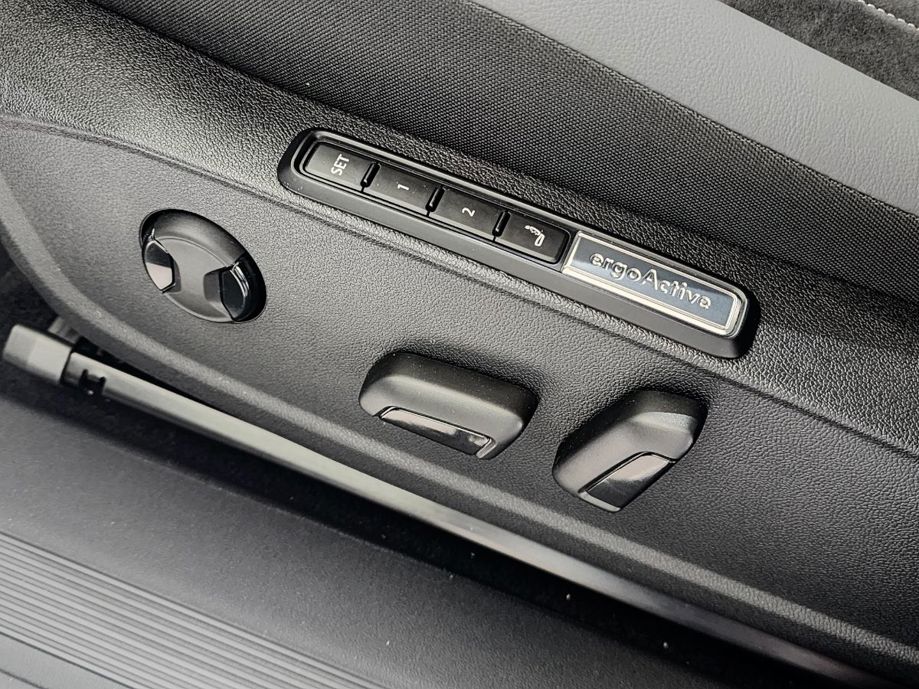
At the risk of seeming unappreciative at this options-list generosity, the Pro+ is not the one we’d recommend right now. VW’s big ID discounts don’t apply to this model, so it’s still listed at the original $95,490. The ID.5 Pro, however, has been reduced from $86,490 to just $64,990, and given it’s mechanically/electrically the same apart from smaller 19in wheels, a $30k price leap is pretty much impossible to justify.
We’re looking forward to finding out what VW’s idea of a People’s Car circa-2024 is like to live with.
It might be a moot point anyway, because a search of current NZ stock (you can do that on the VW NZ website here) at the time of writing reveals 27 ID.5 Pro models available, but not a single Pro+.

Like we said, they’re almost identical to drive, so we’ll keep a level head about the Pro+ extras and report on the ID.5 as an overall EV experience. And if we get a little massage along the way, what’s the harm?
We’re looking forward to finding out what VW’s idea of a People’s Car circa-2024 is like to live with, whether we do prefer the ID’s handling/ride balance to the sister Enyaq (the VW is sharper, the Skoda softer) and how day-to-driving will get us in synch with the ID’s still-controversial dashboard layout, which has virtually no physical controls and relies instead on haptic feedback and touch-sensitive sliders.
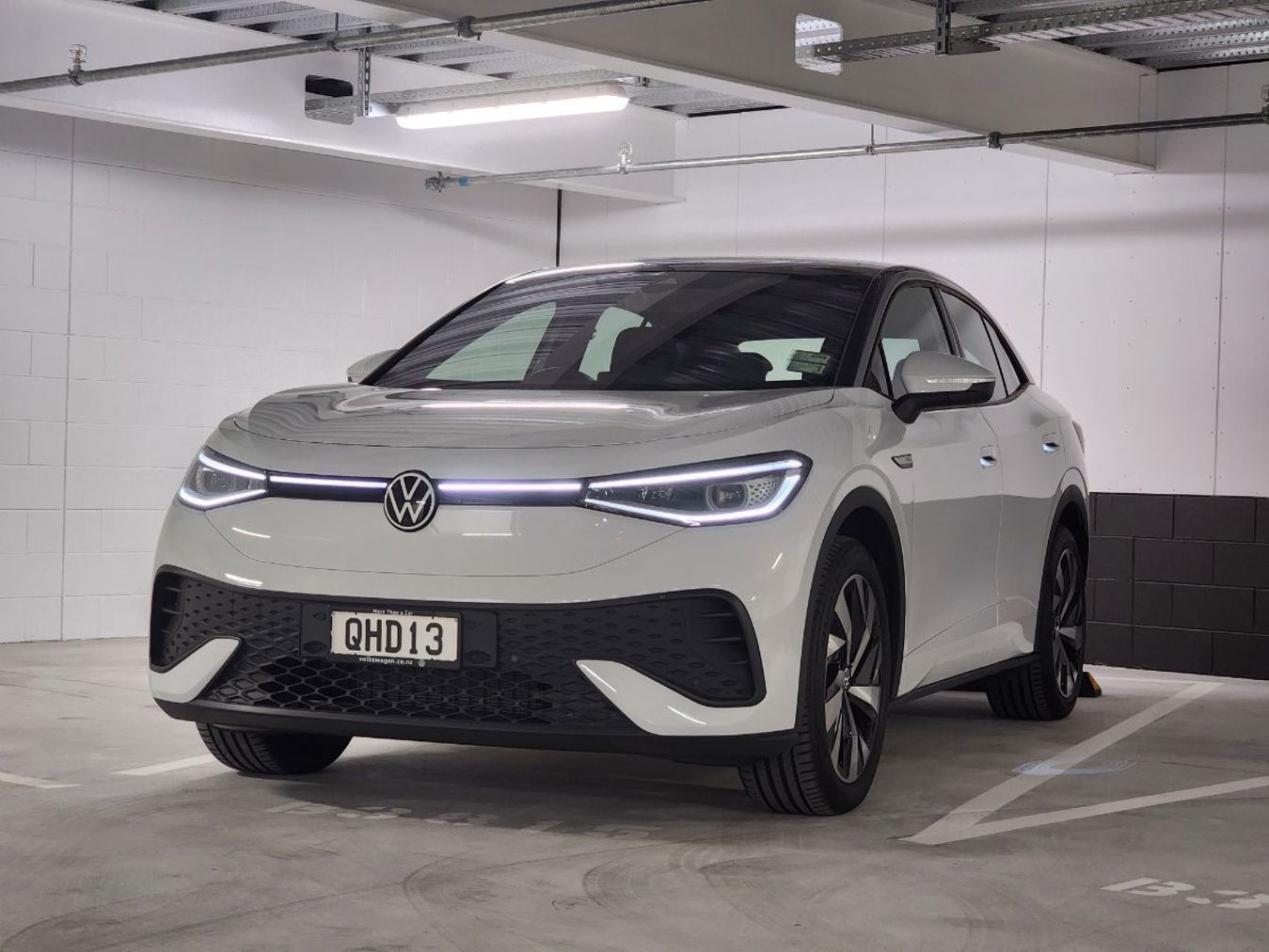
It has one of those fancy intelligent voice assistants, too; so Hello ID, we’re ready to go.
- David Linklater
What is the Volkswagen ID.5 Pro+?
The coupe version of VW's ID.4 electric SUV. It's based on the group's MEB platform (Skoda, Cupra share it), so this is really the core of VW's EV offering.
Why are we running it?
To find out whether VW has nailed this EV thing in the middle of an uncertain zero-emissions vehicle market in NZ.


























